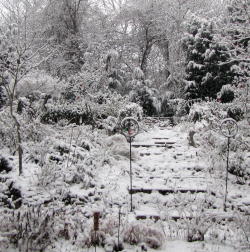
While we have our share of daffodils, tulips, hyacinths and the like, there is also an attraction here to the little oddballs of the bulb world, the Fritillaria ssp. Fritillaria is a genus in the Liliaceae family distributed throughout Europe and North Africa (especially around the Mediterranean), temperate Asia and North America. Most of them have pendant flowers but many of these are not brilliantly colored, although they may have attractive markings. Some of the species have a “foxy” odor. The name of the genus is said to come from the latin fritillus or dice box. Many of the species have spotted or checked flowers. Fritillary or fritillaries is also a common name for butterflies in the family Nymphalidae, again deriving from their patterned wings. John Gerrard, page 123, in his book The Herball, or Generall Historie of Plantes published in 1597, says the name may derive from the tables at which chess or dice was played, frittillo.

Several of the little fritts have performed well in the Fairegarden. One species that has gone above and beyond the call of duty is Fritillaria meleagris, the checkered lily.

The name meleagris means ‘spotted like a guinea fowl’. We began with a planting of five bulbs. When those proved to be happy here, many more were added. It is hoped they will seed about to make a grand show someday.

In the mixture of colors, some are solid white. The spots are aphids, sad to say. But there have been lady beetles spotted in the garden, and they will gobble up these nasty juice-suckers. If these bad bugs are too annoying before that happens, I will give them a hard squirt with the water hose, no need for nasty chemical pesticides at all.

I like it when the flowers can’t make up their mind whether to be maroon or white, so choose both!

Another little fritt well represented here is Fritillaria uva-vulpis, synonymous with F. assyriaca. The common name is fox’s grape, and the color and shape do suggest single grapes. Mass quantities of these very small bulbs were planted along the forty foot wall behind the main house, the first fall after the wall was constructed, in 2001.

Said to be the easiest to grow of the fritts, the colors of brownish maroon with a yellow band are quite subtle, not very showy alone. But as this shot with Muscari armeniacum, grape hyacinths shows, it plays well with others.

If you are waiting for these little bells to open up, better get a tall coffee and a good book, this is all the farther they widen.

Newly added in the fall of 2010 was a patch of Fritillaria pontica along the double wall that had been a condo for voles. After digging out the dirt and lining it with hardware cloth cages, laying sharp gravel in the bottom, then putting the dirt back, we are proud to say that all of the bulbs were unscathed. Click here for the entire story.

There seems to be some variation with these little fritts, as well.

Please excuse my gardener’s fingers in many of these shots. The flowers hang downward and the pretty parts need to be showcased with a little human help. This little fritt is also said to be among the easiest and should naturalize here. We like naturalizing things!

Newly added in the fall of 2011, Fritillaria davisii, all five of them, were planted along a newly dug edging in the white/yellow garden. These are really tiny plants, only a few inches tall. They get lost with the similar color violas, in fact. Perhaps they need to be moved to a better location for viewing, and picture taking. Those days of easily laying flat on my stomach on gravel paths to do some garden snapping with the camera are getting more and more difficult with each passing year.

The side view of F. davisii shows the similarity in color and form to F. meleagris, which are much, much taller.

There have been other fritts planted here that either did not return, as the case with Fritillaria raddeana, above, or never came up at all, like Fritillaria persica. It is fun to try new things, especially new plant type things. If some end up doing well and liking the neglectful conditions here, the entire enterprise can be considered a success. For in the realm of bulbs, more is never enough.
Frances









I just started adding fritts last year…some new ones added in the fall and can’t wait to see them…I just adore the colors and patterns.
Frances, They really are special little bulbs and your photos are fantastic. My contortion photo days are over, too. But, thank you for the shots of the tiny frits. I have admired and tried checkered lily, but, need to find the right spot for them. Loved the fox grape, too. xoxogail
I find myself getting down on the ground more and more as I experiment with photographing my flowers – but it’s harder and harder to get back up. Thanks for showing us the fritts – I never knew there were so many different one.
If I was just looking at the pictures casually and not paying attention to foliage or your wonderful detailed descriptions, I might think some of these charmers were hellebores. You are a convincing advocate for the notion of trying new things.
More IS never enough with the little bulbs. Well said. You have given me some new ones to plant!
I now need to add these…must do some research though because I have it in my head they don’t like it here and don’t know why I think that. I hope I am remembering wrong…yours are lovely!
Eee! I LOVE Fritt-type flowers~ Those almost perfect checker board patterns are so interesting to find on a flower! I’m amazed at how tiny some of the flowers are, especially when compared to the gardener’s fingers!
After obsessing on seeing them on various platforms I was determined to get some of my own – I was gifted a Frittilaria imperalis [unknown the type…] and some of the “Fox’s Grapes” I purchased on a whim. The imperalis had three babies so they were planted vicariously in the garden and they’re all growing! “Fox’s Grape”? Well, I planted them too late so hopefully they’ll at least leaf out this year, but I’m grateful to see the photos of yours! They’re splendid!
We can only easily grow the Snakeshead so it is wonderful to see these varietes in your garden.
Okay, Frances, your great photos have convinced me to try a few of the checkered Fritts this fall. It’s too boring to grow only the safe stuff, and I like pushing the boundaries, finding some successes in adjusting the soil, light, and location just so. (Corydalis ‘Berry Exciting’ is flourishing for me in Texas heat. It’s worth the initial trouble and makes me smile.) You know, sometimes it works, sometimes it doesn’t, but at least we give it a shot and try something new and exciting for our particular area. Thanks for the encouragement to your readers!
So few Southern gardeners grow fritts. I’ve always admired them in the catalogs, but your photos are the only ones that I’ve seen where they were growing in a garden. I think they’re so unusual and pretty.
I’ve only ever grown, or should I say tried and failed to grow, the tall fritillarias. Having seen your photos, I think I’ll have a go with the small ones instead.
I had F. pallidiflora one year, a lovely pale yellow similar to the F. pontica. It didn’t come back a second year and I don’t know why. I would like to try it again.
I’ve seen the Fritillaria meleagris before in catalogs, but I had no idea that there were so many other kinds of Fritillarias! They are very pretty in their own subdued way. I loved seeing all the different ones in your garden!
I have tried the larger fritts here but they never return. Maybe the smaller ones are a little more hardy. I might give them a try. They are darling.
You never fail to make me smile in the morning, Frances–I’m glad to see the ponticas have taken up residence in the “vole condo”–they’re much prettier than the former inhabitants:) Every fall I debate about adding a few of these to my garden; I should look at this post later this season–your photos are so much more appealing than any catalog photo of them! I especially love the grouping with the muscari.
I love the fritillaries, so was delighted with this post. Persicaria always comes up for me, but never blooms…a shame to miss those brooding, dark blossoms.
Pingback: Is your Garden Predator Friendly? « sorticulturist
I have such a little garden. Reading about yours makes me think I have acres. Thanks for sharing!
Lured by the color, I tried F. persica, but they did not even come up. Perhaps I will have to try one of yours.
Pingback: Is your Garden Predator Friendly? | sorticulturist